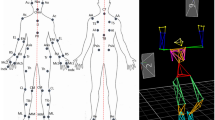Abstract.
This study re-investigates the characteristics of segmental postural adjustments associated with rapid mono-articular movements and analyses their dependence on initial postural conditions. Subjects performed rapid voluntary wrist flexions and extensions while maintaining their upper limb posture as stable as possible, with or without an elbow support. Surface electromyographic activity (EMG) was recorded from Flexor carpi ulnaris, Extensor carpi radialis, Biceps brachii, Triceps brachii and Deltoideus anterior. The kinematics of the three joints and kinetics in the support condition were also recorded. A planar mechanical model was used to determine the muscle torque required to keep the upper limb posture constant while performing wrist movements. All subjects showed anticipatory postural adjustments (APA) which, unlike those described for whole-body postural control, could not counteract in advance the perturbing inter-segmental forces created by the movement. Postural muscles were activated before the wrist movement with a chronology specific to the direction of the wrist movement. Some postural muscular activities anticipated that of the prime-movers in accordance with muscle torque, which had to be applied to the joints to keep the upper limb posture constant. These results reveal that the central nervous system (CNS) uses the same organization of the motor command for the control of both segmental and whole-body posture: APA and corrective postural adjustments (CPA), which are based on well-organized anticipatory postural muscle activities (APMA), except that APA can be non-efficient in segmental postural control. The presence or absence of an elbow support influenced the level of activation of postural muscle but not their chronology. This result suggests that the CNS uses a sequence of APMA: a postural muscle synergy which is predetermined as a function of the intended direction of the movements and modulates the gain towards certain muscles, in accordance with the gravitational effects, and supports reaction changes.
Similar content being viewed by others
Author information
Authors and Affiliations
Additional information
Electronic Publication
Rights and permissions
About this article
Cite this article
Chabran, E., Maton, B., Ribreau, C. et al. Electromyographic and biomechanical characteristics of segmental postural adjustments associated with voluntary wrist movements. Exp Brain Res 141, 133–145 (2001). https://doi.org/10.1007/s002210100823
Received:
Accepted:
Issue Date:
DOI: https://doi.org/10.1007/s002210100823




